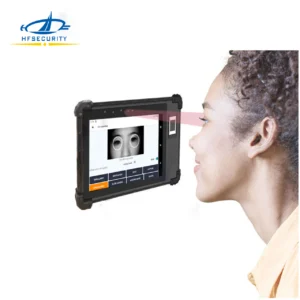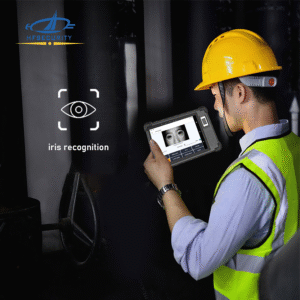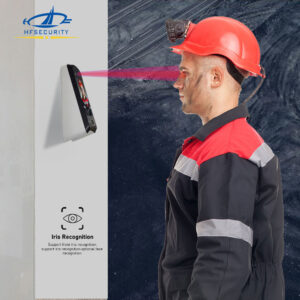Common Mistakes When Using an Iris Scanner
1.Poor Eye Positioning
Incorrect eye positioning is one of the most common causes of iris recognition failure. If the eye is too close, too far, or misaligned with the iris scanner sensor, the system may fail to capture a clear image, resulting in repeated scans or false rejections. Proper alignment ensures faster authentication and higher biometric accuracy.
Best Practices for Correct Eye Positioning:
Align Your Eye Properly: Position the eye at the recommended distance and height from the iris scanner. Most devices have built-in guides or on-screen prompts to assist users.
Maintain a Comfortable Distance: Avoid leaning too close or sitting too far. A stable and consistent distance improves recognition speed and reduces errors.
Use Alignment Aids: Follow on-screen indicators, alignment frames, or physical guides if available, as they help ensure the eye is correctly positioned for accurate scanning.
Stay Still During Scan: Sudden movements or blinking can interfere with the sensor’s ability to capture a precise iris pattern.
Tips for Optimal Iris Recognition:
Proper eye positioning not only increases scan success rates but also enhances overall system reliability in high-security environments.
2.Dirty or Obstructed Sensors
A dirty or obstructed iris scanner lens can severely impact iris recognition accuracy. Dust, fingerprints, smudges, or other foreign particles on the sensor may lead to failed scans, repeated attempts, or even false rejections. Maintaining a clean sensor is essential for reliable biometric authentication.
Best Practices for Iris Scanner Maintenance:
Regular Cleaning: Use a soft, lint-free microfiber cloth to gently wipe the iris sensor. Avoid abrasive materials or harsh chemicals that may scratch the optical lens.
Use Lens-Safe Cleaning Solutions: For stubborn smudges, lightly dampen the cloth with a lens-safe cleaning solution. Never pour liquids directly onto the sensor.
Avoid Direct Contact: Do not touch the sensor with fingers or sharp objects, as oils and scratches can reduce sensor performance and degrade iris recognition reliability.
Maintain a Clean Environment: Place the device in a clean, dry location to minimize dust accumulation. Cover the iris scanner when not in use to prevent debris buildup.
Periodic Inspection: Regularly check the sensor for scratches, condensation, or obstructions that may interfere with infrared or optical components.
Tips for Optimal Performance:
Keeping the iris scanner clean not only ensures higher recognition accuracy but also prolongs the lifespan of the device. This is particularly important for high-security environments where reliable biometric authentication is critical.
3.Improper Lighting Conditions
Lighting conditions play a critical role in iris recognition accuracy. Extreme lighting—whether too bright or too dim—can prevent the iris scanner from capturing a clear and detailed image, leading to failed scans, slow authentication, or false rejections.
Tips for Optimal Lighting:
Avoid Direct Sunlight: Direct exposure to sunlight can create glare on the iris scanner lens, interfering with the sensor’s infrared capture.
Minimize Reflections: Reflective surfaces near the scanner, such as mirrors or glass, can distort the iris pattern and reduce recognition performance.
Reduce Strong Shadows: Shadows on the face or around the eyes may obscure key iris features. Ensure even lighting for consistent scans.
Use Indoor or Controlled Lighting: Indoor environments with soft, diffused lighting generally provide the best conditions for accurate iris recognition.
Follow Device Prompts: Many iris scanners have on-screen guidance for proper positioning and lighting—use these cues to improve scan success rates.
Tips for High-Accuracy Iris Recognition:
Maintaining proper lighting not only ensures faster and more reliable authentication but also enhances overall biometric security, especially in high-security environments.
4.Software Issues
Outdated firmware or iris recognition software can cause errors, slow performance, or reduced biometric accuracy. Running old versions may also result in incompatibility with new security protocols or system integrations. Keeping the device and software up-to-date is essential for reliable and efficient iris authentication.
Best Practices for Software Maintenance:
Regular Firmware Updates: Check for firmware updates from the manufacturer and apply them promptly. Updated firmware often improves recognition algorithms and overall system stability.
Update Iris Recognition Software: Ensure that the iris recognition application is the latest version to benefit from bug fixes, enhanced features, and optimized performance.
System Compatibility: Keep your device compatible with other access control systems, time attendance software, or biometric management platforms by maintaining updated software.
Scheduled Maintenance Checks: Periodically review the device and software logs to detect errors or performance issues early.
Tips for Optimal Performance:
Regularly updating firmware and software not only improves iris recognition accuracy but also enhances system security, reduces errors, and ensures seamless integration with other devices or platforms.
Ignoring Enrollment Procedures
Proper enrollment is the foundation of accurate iris recognition. Skipping or rushing the enrollment process can lead to poor-quality iris templates, which may cause repeated scan failures, slower authentication, or false rejections. High-quality enrollment ensures faster, more reliable biometric authentication in daily use.
Best Practices for Iris Enrollment:
Follow Instructions Carefully: Always follow the device’s guidelines for capturing clear and focused iris images. Proper positioning, lighting, and distance are critical during enrollment.
Avoid Rushing: Take sufficient time to complete the enrollment process. Multiple scans from slightly different angles can help create a robust iris template.
Verify Enrollment Quality: Some systems provide quality scores or indicators—use these to confirm the iris images are captured correctly.
Periodic Re-Enrollment (If Needed): In high-security environments, periodic re-enrollment may help maintain system accuracy as users’ physical conditions change over time.
Tips for Optimal Enrollment:
High-quality enrollment not only improves recognition accuracy but also reduces future errors, enhances system efficiency, and ensures consistent iris scanner performance over time.
Common Mistakes When Using an Iris Scanner
When operating an iris scanner, users often make a few common mistakes that can affect accuracy and speed:
Incorrect eye positioning – standing too close, too far, or misaligned with the sensor.
Dirty or obstructed sensors – dust, fingerprints, or smudges reduce performance.
Improper lighting conditions – direct sunlight, glare, or shadows can interfere with recognition.
Outdated software or firmware – failing to update may cause recognition errors.
Poor enrollment process – unclear or rushed enrollment leads to ongoing identification problems.
Phần kết luận
Avoiding these common mistakes and following best practices ensures that iris scanning remains fast, accurate, and secure. Paying attention to eye positioning, lighting, sensor cleanliness, and proper enrollment can significantly enhance the performance of any iris scanner.
Câu hỏi thường gặp
Yes, modern scanners can accurately read eyes through glasses or contacts.
Clean the sensor weekly or whenever smudges or dust are visible.
Yes, they are designed for schools, offices, airports, and other high-traffic areas.
Yes, extreme light can affect recognition, but adaptive illumination in many scanners helps mitigate this issue.
Liên hệ chúng tôi
We would love to speak with you.
Feel free to reach out using the below details.




